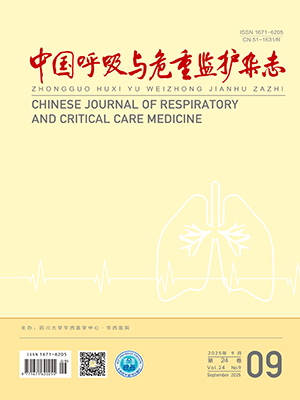| 1. |
Mandell LA, Wunderink RG, Anzueto A, et al. Infectious Diseases Society of America/American Thoracic Society consensus guidelines on the management of community-acquired pneumonia in adults. Clin Infect Dis, 2007, 44 Suppl 2: S27-72.
|
| 2. |
Houck PM, Bratzler DW, Nsa W, et al. Timing of antibiotic administration and outcomes for Medicare patients hospitalized with community-acquired pneumonia. Arch Intern Med, 2004, 164(6): 637-644.
|
| 3. |
Menéndez R, Sahuquillo-Arce JM, Reyes S, et al. Cytokine activation patterns and biomarkers are influenced by microorganisms in community-acquired pneumonia. Chest, 2012, 141(6): 1537-1545.
|
| 4. |
Macfarlane JT, Boldy D. 2004 update of BTS pneumonia guidelines: what's new. Thorax, 2004, 59(5): 364-366.
|
| 5. |
Fine MJ, Auble TE, Yealy DM, et al. A prediction rule to identify low-risk patients with community-acquired pneumonia. N Engl J Med, 1997, 336(4): 243-250.
|
| 6. |
Lim WS, van der Eerden MM, Laing R, et al. Defining community acquired pneumonia severity on presentation to hospital: an international derivation and validation study. Thorax, 2003, 58(5): 377-382.
|
| 7. |
Chalmers JD, Singanayagam A, Akram AR, et al. Severity assessment tools for predicting mortality in hospitalised patients with community-acquired pneumonia. Systematic review and meta-analysis. Thorax, 2010, 65(10): 878-883.
|
| 8. |
Man SY, Lee N, Ip M, et al. Prospective comparison of three predictive rules for assessing severity of community-acquired pneumonia in Hong Kong. Thorax, 2007, 62(4): 348-353.
|
| 9. |
Aujesky D, Auble TE, Yealy DM, et al. Prospective comparison of three validated prediction rules for prognosis in community-acquired pneumonia. Am J Med, 2005, 118(4): 384-392.
|
| 10. |
Müller B, Becker KL, Schächinger H, et al. Calcitonin precursors are reliable markers of sepsis in a medical intensive care unit. Crit Care Med, 2000, 28(4): 977-983.
|
| 11. |
Viasus D, Del RG, Simonetti AF, et al. Biomarkers for predicting short-term mortality in community-acquired pneumonia: A systematic review and meta-analysis. J Infect, 2016, 72(3): 273-282.
|
| 12. |
Liu D, Su LX, Guan W, et al. Prognostic value of procalcitonin in pneumonia: a systematic review and meta-analysis. Respirology, 2016, 21(2): 280-288.
|
| 13. |
社区获得性肺炎诊断和治疗指南. 中华结核和呼吸杂志, 2006, 29(10): 651-655.
|
| 14. |
Polzin A, Pletz M, Erbes R, et al. Procalcitonin as a diagnostic tool in lower respiratory tract infections and tuberculosis. Eur Respir J, 2003, 21(6): 939-943.
|
| 15. |
Hirakata Y, Yanagihara K, Kurihara S, et al. Comparison of usefulness of plasma procalcitonin and C-reactive protein measurements for estimation of severity in adults with community-acquired pneumonia. Diagn Microbiol Infect Dis, 2008, 61(2): 170-174.
|
| 16. |
Hedlund J, Hansson LO. Procalcitonin and C-reactive protein levels in community-acquired pneumonia: correlation with etiology and prognosis. Infection, 2000, 28(2): 68-73.
|
| 17. |
Kasamatsu Y, Yamaguchi T, Kawaguchi T, et al. Usefulness of a semi-quantitative procalcitonin test and the A-DROP Japanese prognostic scale for predicting mortality among adults hospitalized with community-acquired pneumonia. Respirology, 2012, 17(2): 330-336.
|
| 18. |
Krüger S, Ewig S, Marre R, et al. Procalcitonin predicts patients at low risk of death from community-acquired pneumonia across all CRB-65 classes. Eur Respir J, 2008, 31(2): 349-355.
|
| 19. |
Fernandes L, Arora AS, Mesquita AM. Role of semi-quantitative serum procalcitonin in assessing prognosis of community acquired bacterial pneumonia compared to PORT PSI, CURB-65 and CRB-65. J Clin Diagn Res, 2015, 9(7): OC01-4.
|
| 20. |
Ahn S, Kim WY, Kim SH, et al. Role of procalcitonin and C-reactive protein in differentiation of mixed bacterial infection from 2009 H1N1 viral pneumonia. Influenza Other Respir Viruses, 2011, 5(6): 398-403.
|
| 21. |
Johansson N, Kalin M, Backman-Johansson C, et al. Procalcitonin levels in community-acquired pneumonia - correlation with aetiology and severity. Scand J Infect Dis, 2014, 46(11): 787-791.
|
| 22. |
Assicot M, Gendrel D, Carsin H, et al. High serum procalcitonin concentrations in patients with sepsis and infection. Lancet, 1993, 341(8844): 515-518.
|
| 23. |
刘又宁, 陈民钧, 赵铁梅, 等. 中国城市成人社区获得性肺炎 665 例病原学多中心调查. 中华结核和呼吸杂志, 2006, 29(1): 3-8.
|
| 24. |
Schuetz P, Suter-Widmer I, Chaudri A, et al Prognostic value of procalcitonin in community-acquired pneumonia. Eur Respir J, 2011, 37(2): 384-392.
|
| 25. |
Menéndez R, Martínez R, Reyes S, et al. Biomarkers improve mortality prediction by prognostic scales in community-acquired pneumonia. Thorax, 2009, 64(7): 587-591.
|
| 26. |
Yang Y, Xu F, Shi LY, et al. Efficacy and significance of various scores for pneumonia severity in the management of patients with community-acquired pneumonia in China. Chin Med J (Engl), 2012, 125(4): 639-645.
|
| 27. |
Naderi HR, Sheybani F, Sarvghad M, et al. Can procalcitonin add to the prognostic power of the severity scoring system in adults with pneumonia?. Tanaffos, 2015, 14(2): 95-106.
|




